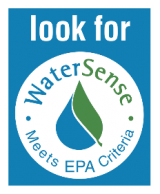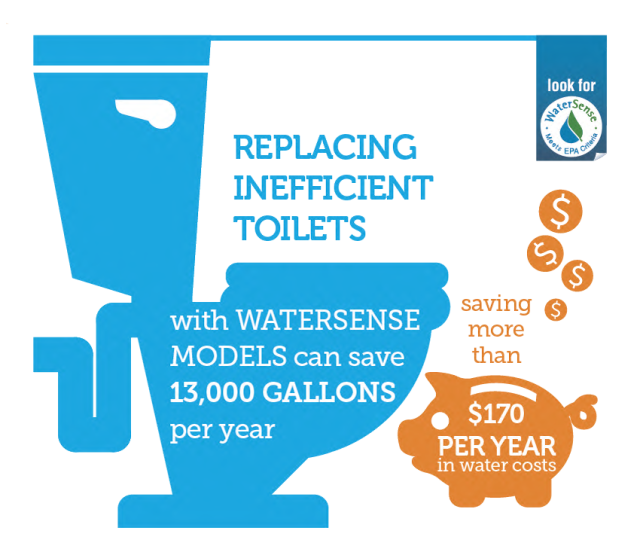Residential Toilets


Toilets are by far the main source of water use in the home, accounting for nearly 30 percent of an average home's indoor water consumption. Older, inefficient toilets that use as much as 6 gallons per flush also happen to be a major source of wasted water in many homes.
On This Page:
Flush Facts
Design improvements have allowed toilets to use 1.28 gallons per flush or less while still providing equal or superior performance. This is 20 percent less water than the current federal standard of 1.6 gallons per flush. WaterSense labeled toilets are independently certified to meet EPA's criteria for both performance and efficiency. Only water-saving toilets that complete the third-party certification process can earn the WaterSense label.

Whether remodeling a bathroom, starting construction of a new home, or simply replacing an old, leaky toilet that is wasting money and water, installing a WaterSense labeled toilet is a high-performance, water-efficient option worth considering. WaterSense labeled toilets are available at a wide variety of price points and a broad range of styles and in many areas, utilities offer rebates and vouchers that can lower the price of a WaterSense labeled toilet. If you opt for a WaterSense labeled dual-flush toilet, you can save even more water by choosing a "reduced flush" mode that uses a smaller volume of water to remove liquid waste.
WaterSense Savings

By replacing old, inefficient toilets with WaterSense labeled models, the average family can reduce water used for toilets by 20 to 60 percent—that's nearly 13,000 gallons of water savings for your home every year! They could also save more than $170 per year in water costs, and $3,400 over the lifetime of the toilets.
Nationally, if all old, inefficient toilets in the United States were replaced with WaterSense labeled models, we could save more than 260 billion gallons of water per year, or the amount of water that flows over Niagara Falls in about five days.
Household leaks can waste 180 gallons per week. Toilets are often the culprit. Most toilet leaks are due to old or worn-out toilet flappers (e.g., valve seal). A flapper is an inexpensive part, typically made from rubber, plastic, or silicone, that controls the flow of water to the toilet bowl. Replacing one is quick and easy. To see how easy it is check out our WaterSense Bath Hack Video.
- WaterSense Bath Hack #3 shows how easy it is to Replace Your Leaky Toilet Flapper.
Performance
The former “low-flow” toilets of the 1990s were sometimes associated with performance issues (e.g., requiring double flushing) and poor user satisfaction. However, manufacturers have worked diligently since that time to redesign and reengineer their products to achieve both efficiency and performance. Beginning in early 2006, EPA worked with a variety of stakeholders to develop performance criteria in addition to water efficiency criteria to recognize the advancements in technology and help overcome the perceptions of the past. This included the adoption of a novel test to assess the ability of the toilet to clear waste from the bowl. WaterSense performance criteria have since been adopted into the national plumbing standard, American Society of Mechanical Engineers (ASME) A112.19.2/Canadian Standards Association (CSA) B45.1 Ceramic Plumbing Fixtures. In reality, despite using significantly less water, the WaterSense labeled toilets that are designed and sold today far outperform traditional toilets from the 1980s and 1990s.
All WaterSense labeled tank-type toilets must comply with and are independently certified to meet the same rigorous performance requirements as standard toilets, including:
- Mixed testing media flushability: Ability to flush testing media of different sizes and density (i.e., floating versus sinking media).
- Bowl surface cleaning: Ability to clean the surface of the bowl.
- Drainline waste transport: Ability to transport waste media through a drainline.
- Waste extraction: Ability to clear soybean paste test media and toilet paper (meant to be representative of human waste) from the bowl.
For more information on how WaterSense assessed performance when developing the specification:
Specification
On June 2, 2014, EPA released a revised version of the WaterSense Specification for Tank–Type Toilets (Version 1.2). Version 1.2 of the specification will remain in effect until June 30, 2025.
- Version 1.2 of the WaterSense Specification for Tank-Type Toilets (PDF) (6 pg, 48K, About PDF)
- Summary of Revisions to the WaterSense Specification for Tank-Type Toilets (Version 1.2) (PDF) (5 pg, 52K, About PDF)
In May 2024, EPA released a major revision to the WaterSense Specification for Tank–Type Toilets (Version 2.0). Version 2.0 of the specification will take effect on July 1, 2025. Within the revised specification, EPA modified the water efficiency criteria for dual-flush toilets by eliminating the effective flush volume calculation and instead establishing the same maximum flush volume requirement - 1.28 gallons per flush - for both single-flush toilets and full-flush modes of dual-flush toilets. Additionally, EPA improved readability throughout the specification by simplifying language, aligning language to maintain consistency with similar WaterSense specifications, and consolidating reference ASME standards to reduce redundancy. EPA also incorporated clarifications that have been made to the specification since its original publication.
- WaterSense Specification for Tank-Type Toilets, Version 2.0 (pdf)
- Summary of Revisions to the WaterSense Specification for Tank-Type Toilets, Version 2.0 (pdf)
- Draft Version 2.0 of the WaterSense Specification for Tank-Type Toilets Public Comment Response (pdf)
- Draft Version 2.0 of the Specification for Tank-Type Toilets Public Comment Compilation (pdf)
For more information about the WaterSense specification development process for toilets, please see the Tank-Type Toilet Specification Background Materials page.
Manufacturers that produce tank-type toilets meeting EPA's efficiency and performance criteria can apply to have their products certified to earn the WaterSense label. Before submitting products for testing, manufacturers must have a partnership agreement with EPA in place. Visit the manufacturer section on the partner page to learn more.
Specification Transition
Version 2.0 of this specification constitutes a major revision because it will affect the certification status of some WaterSense labeled dual-flush toilets certified under Version 1 of the specification. Version 2.0 of the specification will take effect on July 1, 2025. Until then, tank-type toilets can continue to earn the WaterSense label according to the criteria included in Version 1.2 of the specification.
EPA has published documents to outline the transition timeline, how the revisions will affect certification status, and when manufacturers must comply to earn the WaterSense label.
- Transition Agreement for Compliance with Version 2.0 of the WaterSense Specification for Tank-Type Toilets (pdf)
- Partner Guidance on the Transition to Version 2.0 of the WaterSense Specification for Tank-Type Toilets (pdf)
By October 1, 2025, licensed certifying bodies are required to update their certification listings and submit an updated list of WaterSense labeled products to EPA using Version 4.0 of the product notification template. EPA is including Version 4.0 of the product notification template here for reference; however it requests that licensed certifying bodies not submit this version of the template until AFTER July 1, 2025.
